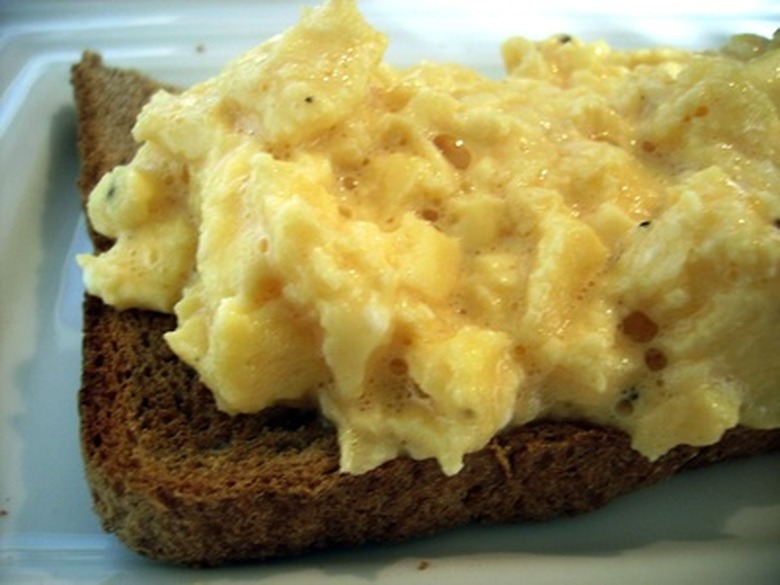What Are The Functions Of Triglyceride Phospholipid & Sterol?
Lipids are organic compounds (that is, they contain carbon, hydrogen and oxygen) that are not water-soluble, instead dissolving in fatty solvents. Three types of lipids are found in the human body and in the foods that people eat: triglycerides, phospholipids and sterols. "Lipid," "fat" and "oil" are often used interchangeably in a nutrition context; solid lipids make up fats, while lipids in liquid form are called oils.
Just as nucleotides are the basic units of DNA molecules, fatty acids are basic units of structure in triglycerides and phospholipids. The basic structural unit of a sterol is a group of four connected carbon-hydrogen rings.
Triglyceride Structure and Function
Triglyceride Structure and Function
Triglycerides consist of a glycerol "backbone" along with three fatty acids bonded to the backbone in an ester linkage. Glycerol is a three-carbon molecule, C(H2)OH-C(H)OH-C(H2)OH. When one of its hydroxyl groups (-OH) loses a hydrogen, a fatty acid can bind to the oxygen in its place, creating a C-O-C (ester) bond. Fatty acids are four to 24 carbons long; if they have even one double bond, they are considered unsaturated, but are otherwise classified as saturated.
Triglycerides are overwhelmingly the predominant type of lipid found in nature, accounting for 99 percent of lipids in the body and 95 percent of dietary lipids. Triglycerides function in the body mainly as fuels, supplying 9 calories of energy per gram.
The importance of triglycerides in health is undisputed. An overly high triglycerides level is a risk factor for heart disease. On the other hand, some fatty acids are essential, meaning that the body cannot make them and must be ingested from foods. One of these is the omega-3 triglyceride linolenic acid.
Phospholipid Structure and Function
Phospholipid Structure and Function
Phospholipids are fat-related molecules that include phosphorus, fatty acids and a nitrogen-containing base. Like triglycerides, they have a glycerol backbone, but it is attached to two fatty acids and a phosphorus group rather than three fatty acids.
Phospholipids are essential to cells because they make up most of the cell membrane. The phospholipid lecithin is used as an emulsifier in food products, meaning that it keeps fats and liquids mixed together, as in salad dressings. They are also found in wheat germ, peanuts, egg yolks, soybeans and organ meats such as liver.
Sterol Structure and Function
Sterol Structure and Function
Sterols are made up primarily of a signature four-ring structure that contains carbon and hydrogen atoms. Cholesterol is the best known sterol, which is vital in cell membrane structure and is the foundation of numerous important compounds in the body. It is found only in foods of animal origin, but humans do not need to ingest any cholesterol because the body can make what it needs.
Sterols are waxy substances to the touch and do not readily dissolve in water. Some plant sterols can block the absorption of dietary cholesterol.
Extra: Fatty Acid Basics
Extra: Fatty Acid Basics
Saturated fatty acids are solid, whereas unsaturated fatty acids are liquid. Dietary fats consist of both saturated and unsaturated fatty acids. A fatty acid with one double bond is called monounsaturated, and those with two or more are called polyunsaturated. Fatty acids provide immediate energy and can be efficiently stored for later use. They also provide insulation, protection and, in some cases, satiety, and they transport fat soluble vitamins.
Cite This Article
MLA
Beck, Kevin. "What Are The Functions Of Triglyceride Phospholipid & Sterol?" sciencing.com, https://www.sciencing.com/functions-triglyceride-phospholipid-sterol-6698322/. 2 August 2018.
APA
Beck, Kevin. (2018, August 2). What Are The Functions Of Triglyceride Phospholipid & Sterol?. sciencing.com. Retrieved from https://www.sciencing.com/functions-triglyceride-phospholipid-sterol-6698322/
Chicago
Beck, Kevin. What Are The Functions Of Triglyceride Phospholipid & Sterol? last modified March 24, 2022. https://www.sciencing.com/functions-triglyceride-phospholipid-sterol-6698322/
